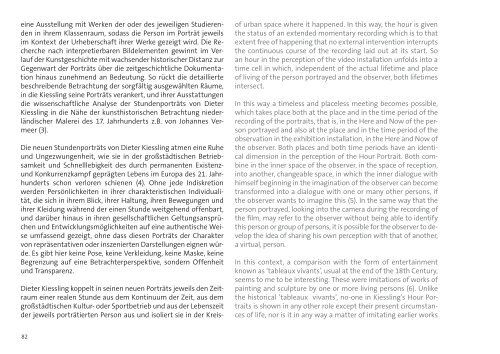DIETER KIESSLING - home
DIETER KIESSLING - home
DIETER KIESSLING - home
Erfolgreiche ePaper selbst erstellen
Machen Sie aus Ihren PDF Publikationen ein blätterbares Flipbook mit unserer einzigartigen Google optimierten e-Paper Software.
eine Ausstellung mit Werken der oder des jeweiligen Studierenden<br />
in ihrem Klassenraum, sodass die Person im Porträt jeweils<br />
im Kontext der Urheberschaft ihrer Werke gezeigt wird. Die Recherche<br />
nach interpretierbaren Bildelementen gewinnt im Verlauf<br />
der Kunstgeschichte mit wachsender historischer Distanz zur<br />
Gegenwart der Porträts über die zeitgeschichtliche Dokumentation<br />
hinaus zunehmend an Bedeutung. So rückt die detaillierte<br />
beschreibende Betrachtung der sorgfältig ausgewählten Räume,<br />
in die Kiessling seine Porträts verankert, und ihrer Ausstattungen<br />
die wissenschaftliche Analyse der Stundenporträts von Dieter<br />
Kiessling in die Nähe der kunsthistorischen Betrachtung niederländischer<br />
Malerei des 17. Jahrhunderts z.B. von Johannes Vermeer<br />
(3).<br />
Die neuen Stundenporträts von Dieter Kiessling atmen eine Ruhe<br />
und Ungezwungenheit, wie sie in der großstädtischen Betriebsamkeit<br />
und Schnelllebigkeit des durch permanenten Existenz-<br />
und Konkurrenzkampf geprägten Lebens im Europa des 21. Jahrhunderts<br />
schon verloren schienen (4). Ohne jede Indiskretion<br />
werden Persönlichkeiten in ihrer charakteristischen Individualität,<br />
die sich in ihrem Blick, ihrer Haltung, ihren Bewegungen und<br />
ihrer Kleidung während der einen Stunde weitgehend offenbart,<br />
und darüber hinaus in ihren gesellschaftlichen Geltungsansprüchen<br />
und Entwicklungsmöglichkeiten auf eine authentische Weise<br />
umfassend gezeigt, ohne dass diesen Porträts der Charakter<br />
von repräsentativen oder inszenierten Darstellungen eignen würde.<br />
Es gibt hier keine Pose, keine Verkleidung, keine Maske, keine<br />
Begrenzung auf eine Betrachterperspektive, sondern Offenheit<br />
und Transparenz.<br />
Dieter Kiessling koppelt in seinen neuen Porträts jeweils den Zeitraum<br />
einer realen Stunde aus dem Kontinuum der Zeit, aus dem<br />
großstädtischen Kultur- oder Sportbetrieb und aus der Lebenszeit<br />
der jeweils porträtierten Person aus und isoliert sie in der Kreis-<br />
82<br />
of urban space where it happened. In this way, the hour is given<br />
the status of an extended momentary recording which is to that<br />
extent free of happening that no external intervention interrupts<br />
the continuous course of the recording laid out at its start. So<br />
an hour in the perception of the video installation unfolds into a<br />
time cell in which, independent of the actual lifetime and place<br />
of living of the person portrayed and the observer, both lifetimes<br />
intersect.<br />
In this way a timeless and placeless meeting becomes possible,<br />
which takes place both at the place and in the time period of the<br />
recording of the portraits, that is, in the Here and Now of the person<br />
portrayed and also at the place and in the time period of the<br />
observation in the exhibition installation, in the Here and Now of<br />
the observer. Both places and both time periods have an identical<br />
dimension in the perception of the Hour Portrait. Both combine<br />
in the inner space of the observer, in the space of reception,<br />
into another, changeable space, in which the inner dialogue with<br />
himself beginning in the imagination of the observer can become<br />
transformed into a dialogue with one or many other persons, if<br />
the observer wants to imagine this (5). In the same way that the<br />
person portrayed, looking into the camera during the recording of<br />
the film, may refer to the observer without being able to identify<br />
this person or group of persons, it is possible for the observer to develop<br />
the idea of sharing his own perception with that of another,<br />
a virtual, person.<br />
In this context, a comparison with the form of entertainment<br />
known as ‘tableaux vivants’, usual at the end of the 18th Century,<br />
seems to me to be interesting. These were imitations of works of<br />
painting and sculpture by one or more living persons (6). Unlike<br />
the historical ‘tableaux vivants’, no-one in Kiessling’s Hour Portraits<br />
is shown in any other role except their present circumstances<br />
of life, nor is it in any way a matter of imitating earlier works


